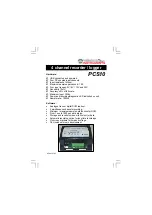
LSI LASTEM M-Log – User’s manual
40
Can be set:
The measure that samples the precipitation;
The minimum time T1 after the first precipitation detection by means of the rain gauge
(instantaneous value > 0);
The minimum time T2 that must pass after the precipitation detection, meanwhile no
precipitation is detected (no precipitation detection by the inner sensor of the rain gauge), to
determinate the end precipitation condition;
The minimum precipitation quantity that determines the start of the precipitation condition.
The alarm condition is detected when T1 time is passed after the first precipitation detection (and
it’s raining again), or is reached the specified rain quantity; anyway if T2 time is passed without any
precipitation detection, the system goes to no alarm condition.
5.5.4
Flood alarm
(Logic used only for M-Log with terminal board inputs – ELO007, ELO008 and ELO011 series)
The logic uses a measure connected to a rain gauge to detect flooding conditions. Can be set:
The measure that surveys the precipitation;
The maximum precipitation quantity in a defined period;
The minimum precipitation quantity in the same period;
The length of alarm or not alarm period.
The alarm condition is detected when, within the specified period that starts from the first
precipitation event, the maximum precipitation quantity is exceeded; from alarm condition
beginning or at the end of the first period, are managed new periods and for each of them the rain
totalization starts from zero; for each new period, if the rain fall quantity returns below the specified
minimum value, the system returns in no alarm condition.
5.5.5
Threshold value compare
The logic detects value overflow or underflow by one or more measures (both univocally and
simultaneously). To the threshold values can be applied a further hysteresis value; this can avoid
continuous alarm state changes in case the measure value moves nearly around the threshold value.
The comparison logics are the following:
Greater than
: alarm in case the measure value if greater than the threshold value added to
the hysteresis; return to no alarm condition when the measure value in lesser than the
threshold value minus the hysteresis; i.e. threshold value=4.0 and hysteresis=0.2 (alarm in
shaded area):
















































